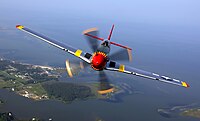
Photo from wikipedia
This study describes combustion features due to streamwise vorticity when using hypermixer struts at Mach numbers of 2.5 and 3.5. Two types of struts are used with hydrogen fuel (at… Click to show full abstract
This study describes combustion features due to streamwise vorticity when using hypermixer struts at Mach numbers of 2.5 and 3.5. Two types of struts are used with hydrogen fuel (at an equivalence ratio of 0.4) injected at sonic speed from the trailing edges of the struts. To study the effects of shockwaves on streamwise vorticity formation and supersonic combustion for an alternating-wedge strut, the intersection point at which the shockwaves cross the central axis is varied by changing the length of the strut. When the incident shock is near the trailing edge of the strut, boundary-layer separation occurs on the ramp of the strut due to pressure increase near the strut and subsonic combustion occurs on the basis of this separation. Conversely, when the incident shock is far from the trailing edge of the strut, a streamwise vortex is generated by the strut and supersonic combustion caused by this vortex makes it effective at entraining fuel into itself. Each flame structure obtained here unquestionably differs in its combustion mode. For a separation-resistant strut, the results show that a streamwise vortex with the required circulation can be induced behind the strut without separation. Moreover, the combustion depends strongly on the incident shockwaves in that the combustion efficiency is not subject to the mixing efficiency because the moderate combustion originates near the point at which the formed streamwise vortex interacts with the shockwaves. Therefore, because an ignition point with moderate combustion can detach from its trailing edge, with a separation-resistant strut, it is possible to control the combustion and avoid an excessive heat load.
Journal Title: Physics of Fluids
Year Published: 2020
Link to full text (if available)
Share on Social Media: Sign Up to like & get
recommendations!